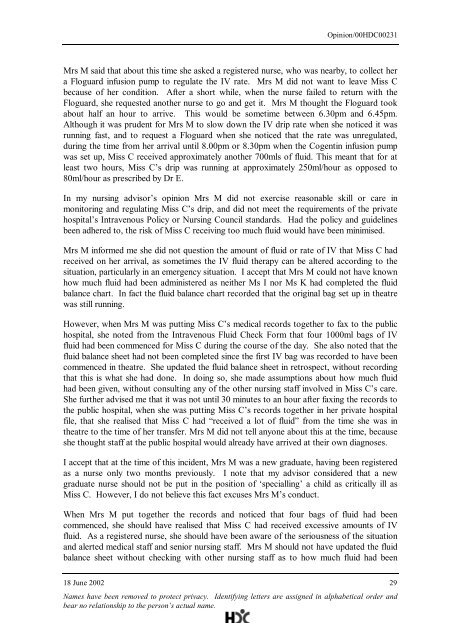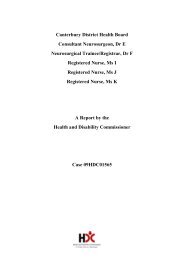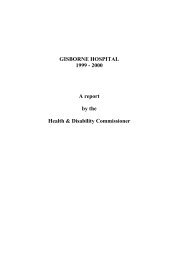Download the pdf version of this decision. - Health and Disability ...
Download the pdf version of this decision. - Health and Disability ...
Download the pdf version of this decision. - Health and Disability ...
Create successful ePaper yourself
Turn your PDF publications into a flip-book with our unique Google optimized e-Paper software.
Opinion/00HDC00231<br />
Mrs M said that about <strong>this</strong> time she asked a registered nurse, who was nearby, to collect her<br />
a Floguard infusion pump to regulate <strong>the</strong> IV rate. Mrs M did not want to leave Miss C<br />
because <strong>of</strong> her condition. After a short while, when <strong>the</strong> nurse failed to return with <strong>the</strong><br />
Floguard, she requested ano<strong>the</strong>r nurse to go <strong>and</strong> get it. Mrs M thought <strong>the</strong> Floguard took<br />
about half an hour to arrive. This would be sometime between 6.30pm <strong>and</strong> 6.45pm.<br />
Although it was prudent for Mrs M to slow down <strong>the</strong> IV drip rate when she noticed it was<br />
running fast, <strong>and</strong> to request a Floguard when she noticed that <strong>the</strong> rate was unregulated,<br />
during <strong>the</strong> time from her arrival until 8.00pm or 8.30pm when <strong>the</strong> Cogentin infusion pump<br />
was set up, Miss C received approximately ano<strong>the</strong>r 700mls <strong>of</strong> fluid. This meant that for at<br />
least two hours, Miss C’s drip was running at approximately 250ml/hour as opposed to<br />
80ml/hour as prescribed by Dr E.<br />
In my nursing advisor’s opinion Mrs M did not exercise reasonable skill or care in<br />
monitoring <strong>and</strong> regulating Miss C’s drip, <strong>and</strong> did not meet <strong>the</strong> requirements <strong>of</strong> <strong>the</strong> private<br />
hospital’s Intravenous Policy or Nursing Council st<strong>and</strong>ards. Had <strong>the</strong> policy <strong>and</strong> guidelines<br />
been adhered to, <strong>the</strong> risk <strong>of</strong> Miss C receiving too much fluid would have been minimised.<br />
Mrs M informed me she did not question <strong>the</strong> amount <strong>of</strong> fluid or rate <strong>of</strong> IV that Miss C had<br />
received on her arrival, as sometimes <strong>the</strong> IV fluid <strong>the</strong>rapy can be altered according to <strong>the</strong><br />
situation, particularly in an emergency situation. I accept that Mrs M could not have known<br />
how much fluid had been administered as nei<strong>the</strong>r Ms I nor Ms K had completed <strong>the</strong> fluid<br />
balance chart. In fact <strong>the</strong> fluid balance chart recorded that <strong>the</strong> original bag set up in <strong>the</strong>atre<br />
was still running.<br />
However, when Mrs M was putting Miss C’s medical records toge<strong>the</strong>r to fax to <strong>the</strong> public<br />
hospital, she noted from <strong>the</strong> Intravenous Fluid Check Form that four 1000ml bags <strong>of</strong> IV<br />
fluid had been commenced for Miss C during <strong>the</strong> course <strong>of</strong> <strong>the</strong> day. She also noted that <strong>the</strong><br />
fluid balance sheet had not been completed since <strong>the</strong> first IV bag was recorded to have been<br />
commenced in <strong>the</strong>atre. She updated <strong>the</strong> fluid balance sheet in retrospect, without recording<br />
that <strong>this</strong> is what she had done. In doing so, she made assumptions about how much fluid<br />
had been given, without consulting any <strong>of</strong> <strong>the</strong> o<strong>the</strong>r nursing staff involved in Miss C’s care.<br />
She fur<strong>the</strong>r advised me that it was not until 30 minutes to an hour after faxing <strong>the</strong> records to<br />
<strong>the</strong> public hospital, when she was putting Miss C’s records toge<strong>the</strong>r in her private hospital<br />
file, that she realised that Miss C had “received a lot <strong>of</strong> fluid” from <strong>the</strong> time she was in<br />
<strong>the</strong>atre to <strong>the</strong> time <strong>of</strong> her transfer. Mrs M did not tell anyone about <strong>this</strong> at <strong>the</strong> time, because<br />
she thought staff at <strong>the</strong> public hospital would already have arrived at <strong>the</strong>ir own diagnoses.<br />
I accept that at <strong>the</strong> time <strong>of</strong> <strong>this</strong> incident, Mrs M was a new graduate, having been registered<br />
as a nurse only two months previously. I note that my advisor considered that a new<br />
graduate nurse should not be put in <strong>the</strong> position <strong>of</strong> ‘specialling’ a child as critically ill as<br />
Miss C. However, I do not believe <strong>this</strong> fact excuses Mrs M’s conduct.<br />
When Mrs M put toge<strong>the</strong>r <strong>the</strong> records <strong>and</strong> noticed that four bags <strong>of</strong> fluid had been<br />
commenced, she should have realised that Miss C had received excessive amounts <strong>of</strong> IV<br />
fluid. As a registered nurse, she should have been aware <strong>of</strong> <strong>the</strong> seriousness <strong>of</strong> <strong>the</strong> situation<br />
<strong>and</strong> alerted medical staff <strong>and</strong> senior nursing staff. Mrs M should not have updated <strong>the</strong> fluid<br />
balance sheet without checking with o<strong>the</strong>r nursing staff as to how much fluid had been<br />
18 June 2002 29<br />
Names have been removed to protect privacy. Identifying letters are assigned in alphabetical order <strong>and</strong><br />
bear no relationship to <strong>the</strong> person’s actual name.
















